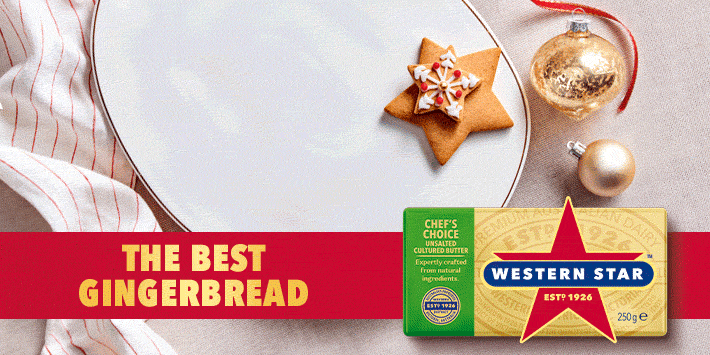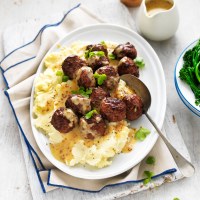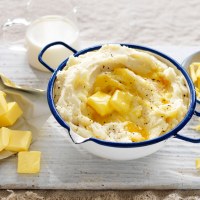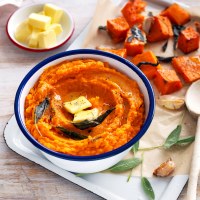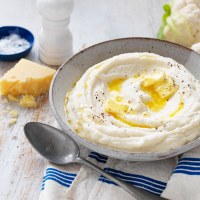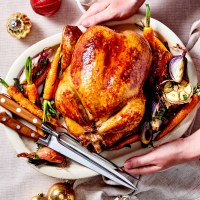How to make the best mashed potatoes
For such a simple side dish, there’s a lot at stake. From choosing the right potatoes to having the right moisture content, these tips will ensure your mash will be the greatest of all time. This classic buttery mash recipe only requires only three simple ingredients, so it's all about using quality ingredients and the right method to get silky, creamy and flavourful mashed potatoes.
Ingredients
- 1kg potatoes
- 100g Western Star Original Salted Butter diced
- ½ cup (125ml) warm milk
- Salt and pepper to taste
Method
- Wash and peel potatoes and cut into large chunks. Place in a medium saucepan and just cover with cold water. Bring to the boil then simmer for 20-25 minutes or until fork tender
- Drain potatoes and return to the dry pan. Shake pan occasionally to remove excess moisture. Mash the potatoes and stir in ¾ of the butter
- Gradually add milk and beat with a wooden spoon until smooth. Season with salt and pepper. Serve topped with remaining butter
7 essential tips for the best mashed potatoes
- Get a head start by choosing the right ingredients. Since there are so few ingredients, their flavours will stand out. A starchy, floury potato such as Sebago is an excellent choice and is readily available all year. Choose firm potatoes that have not sprouted, been bruised or have any soft spots. Western Star's award-winning butter is a pure creamery butter with rich flavour that's perfect for mashed potatoes.
- Don’t cut the potatoes too small, aim for 3-5 cm cubes. Size is important. Smaller chunks reduce cooking time, but also create more surface area which increases the absorption of water into the cells, causing the potato to become water-logged and flavourless. It also increases the loss of starches and flavour into the cooking water.
- Add potatoes to a pan and just cover with cold water only. Always start cooking potatoes in cold water to help dissolve the starch and encourage them to cook evenly. Cooking from boiling sounds like it will work faster, but it can result in an uneven cook, with the outside of the vegetables cooking faster than the inside.
- Cook the potatoes thoroughly, there's nothing worse than hard chunks of uncooked potatoes in your finished mash. Push the tip of a knife or fork into a potato, if there is little or no resistance then it is cooked.
- Avoid mushy, watery mash by "drying off" the excess moisture from the potatoes. Once cooked, drain immediately and return potatoes to the hot pan. Keep the lid off and let it sit for 5-8 minutes, shaking every now and then. This helps excess moisture to steam off, so that your mash has a better texture and flavour.
- Mash your potatoes with either a potato masher, potato ricer, mouli or drum sieve to break down the vegetables without overworking them. Avoid stick blenders or food processors as they will cause more starch to be released and your mash will have a sticky, gummy texture.
- Keep your mash piping hot by using room temperature butter and warmed milk. Add the butter first, as this coats the starches and will help stop your mash from becoming gummy. Then add the milk and other flavours and gently mix through.
What to add to mashed potatoes for flavour
This basic mash can form the base for any flavour. Try these easy ideas:
- Grated cheese, such as cheddar or parmesan
- Finely minced garlic
- Roasted garlic
- Finely chopped parsley, dill, oregano, thyme or chives
- Sour cream
- Garlic powder or onion powder
You can also change up your mash flavours by making a cauliflower or butternut pumpkin mash instead.
How long will mashed potatoes keep?
Between 3 to 5 days when stored in an airtight container in the fridge. Mash without dairy-based ingredients may last a little longer.
How do you reheat mashed potatoes?
Whatever method you choose to heat your mash potato, you want to heat it to at least 70°C for a piping hot mash.
Microwave
Follow directions but adapt based on your microwave power and quantity of mashed potatoes you’re reheating at once.
- Place your mash in a microwave-safe bowl.
- Stir in extra melted butter, and milk/cream. Start with about 1/4 cup of liquid for every 2 cups of potatoes.
- Cover with cling film or microwave-safe lid.
- Microwave on 50% power for 1 minute. Stir gently and place back in the microwave for another minute. Continue stirring and heating like this until the potatoes are heated through. If still too dry, add more liquid.
Oven
The oven is the best method for reheating mashed potatoes. With precise temperature control, this method allows the mash to heat up gradually while retaining moisture and avoiding gelatinisation. It will keep your mash creamy and not dry.
- Place mash potatoes in an oven-safe dish.
- Stir in melted butter, and milk/cream. Start with about ¼ cup liquid for every 2 cups of potatoes.
- Cover the dish with a lid or foil and place in an oven preheated 180°C.
- Cook for 20-30 minutes or until heated through.
Double boiler
Reheating mashed potatoes in a double boiler is relatively quick and helps to stop the mash from drying out. It’s as easy as placing a heat-proof glass bowl on top of a pot filled with water and simmering over medium heat. Make sure to get a lid that fits tightly over the bowl.
- Add the mashed potatoes to the your glass bowl.
- Stir in melted butter, and milk/cream. Start with about ¼ cup liquid for every 2 cups of potatoes.
- Add water to the saucepan. Making sure the water does not touch the bottom of the top bowl.
- Bring water to the simmer with the lid secured over the potatoes. Stir frequently and gently until the potatoes are heated through.
Slow cooker
An easy fuss-free way of heating large amounts of mashed potato. Slow cookers will maintain low even temperatures which helps to get your mash hot without drying out. This is also a great way to keep mash warm if you're entertaining. You will need to start at least 3 hours before you need to serve. Spoon directly into the slow cooker liner and cover with lid. If reheating only small amounts, add to a bowl and place into the slow cooker pour 1 cup of water around the bowl, cover with lid and follow the directions as below.
- Add the mashed potatoes to your slow cooker bowl.
- Stir in melted butter, and milk/cream. Start with about ¼ cup liquid for every 2 cups of potatoes.
- Select LOW for 3-3½ hours.
- Stir once or twice gently until the potatoes are heated through.
What goes with mashed potatoes?
Try these mains that go with mashed potatoes! From easy meatballs to sausages with onion gravy, these simple mains will turn your mash into a satisfying meal. Also, discover other mash recipes using vegetables like pumpkin and cauliflower to add more variety to your meals.
GET THE RECIPE: Cheese, Bacon and Chive Butter Mash by Western Star
GET THE RECIPE: Cheesy Buttery Potato Mash by Western Star






